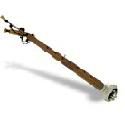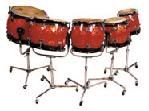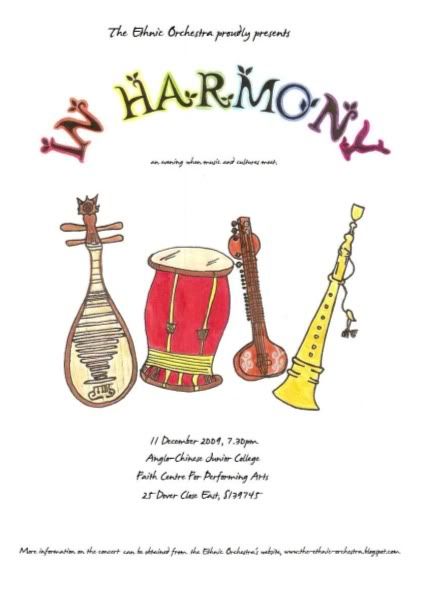Instruments
i)
Malay
Angklung

-originated in Indonesia
-classified an idiophone : creates sound by vibration of the instrument without use of any membrane or strings
-two or three bamboo tubes attached to a bamboo frame
-tubes are carved to give a resonant pitch and are tuned to octaves
-to play: hold base of frame with one hand while using the other to shake the instrument rapidly from side to side
Gendang(Gendung/Kendang)

-classified membranophone
-may be differently made by different groups
-but is a double-headed drum
a) one side(called ibu[mother]) covered by calfskin, larger diameter and lower tone
b) other side(called anak[child]) covered by goatskin, smaller diameter and higher tone
-to play: player to sit with gendang across the lap, slap ends with hands
-many different sounds can be produced, depending on what the player does (eg muting, slapping, near the rim or in the centre)
Bonang

-collection of many small gongs placed horizontally on a wooden frame with strings, typically arranged in two rows.(usually two rows of seven)
-Each gong has its own unique sound.
-to play: strike the knobs of the gongs with tabuh(padded sticks)
ii)
Indian
Sitar(single tumba)

-stringed fretboard instrument
-body made of tun wood + a huge round tumba(resonator) made of seasoned pumpkin gourd
-usually 7 main playing strings above the frets, 11 to 13 sympathetic strings below the frets
-two bridges made of ivory/bone
-to play: pluck!
Tabla

-percussion instrument
-a pair of hand drums of contrasting sizes and timbres
a) a high pitched treble drum(tun wood/teak)
b) a low pitched bass drum (brass)
-heads are made of goatskin
-to play:fingers and palms used to strike the heads(puddi)
Shehnai

-reed oboe
-aerophonic
-tube-like, has 6-9 holes
-two sets of double reeds : quadruple reed instrument
-to play: blow
iii)
Chinese
Erhu

-bowed musical instrument
-two stringed
Dizi

-chinese flute
-usually made of bamboo
-resonance and tone depends on material eg jade less resonant than metal
Paigu

-set of three to seven drums(typically five)
-traditionally made of wood and animal skin heads
-double sided and tunable
-to play: beat heads, sometimes body, with sticks
Music
Indian Ethnic Music
There are many classes when it comes to Indian music. Such include classical music, karnatic music, devotional songs which date up to the 16th century and there are the old folk songs which are usually sung in villages. There are a lot of differences between this music.
Chinese Ethnic Music
Traditional music in China is played on solo instruments or in small ensembles of plucked and bowed stringed instruments, flutes, and various cymbals, gongs, and drums. The scale is pentatonic. Bamboo pipes and qin are among the oldest known musical instruments from China; instruments are traditionally divided into categories based on their material of composition: animal skins, gourd, bamboo, wood, silk, earth/clay, metal and stone. Chinese orchestras traditionally consist of bowed strings, woodwinds, plucked strings and percussion.
Malay Ethnic Music
Percussion instruments are the largest and most important instruments in Malay traditional music. They can be divided into two main sections - tuned and untuned instruments.
Tuned instruments can be divided into two types - instruments which have a basic structure of a set of different sized gongs and instruments which resemble the xylophone. These two types of instruments are classified as idiophones, in which sound is produced as a result of the vibrations made by the instruments itself. There are also idiophones which are classified as untuned e.g. cing, a type of cymbal.
On the other hand, untuned instruments are made up of drums which come in different sizes and shapes, and are classified as membranophones. Membranophones are instruments which produce sound as a result of the vibration of skin which is mounted on the frame of the drum.
Actually, the classification of idiophones and membranophones is not very important because it is only a classification of the instrument structure. For a normal listener, the classification based on the sound which is heard when an instrument is played is more relevant.
Therefore, we will use the classification of tuned and untuned instruments.









